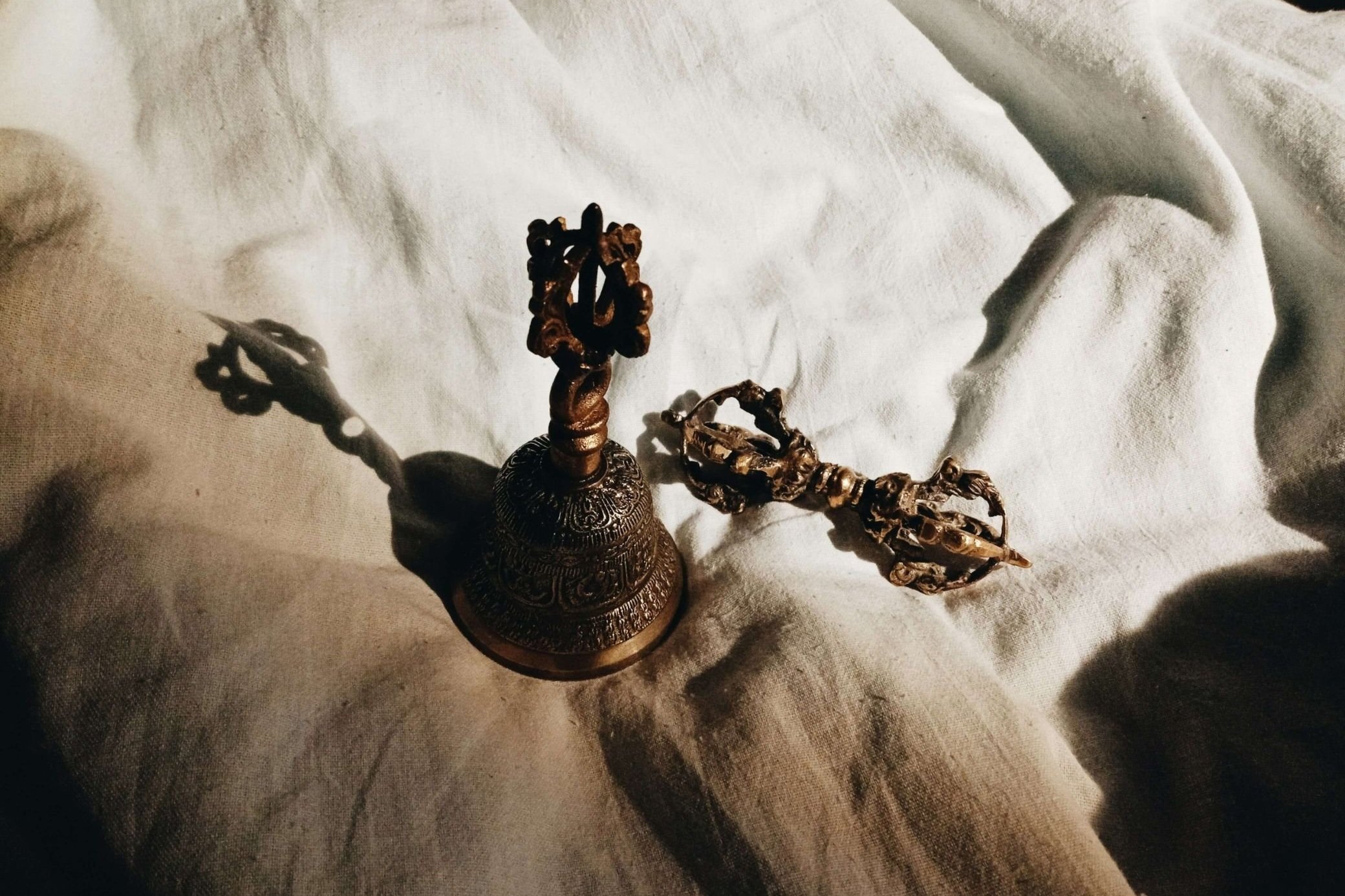Bringing Buddhism to life
“A lot of people withdraw from society, as an experiment... so I thought I would withdraw and see how enlightening it would be. But I found that it’s not enlightening . I think what you are supposed to do is stay in the midst of life.”
For most people at the end of a retreat, there’s usually one question that comes into sharp focus: “How can I take all of this back into my everyday life?”
Often, it’s asked with a sense of desperation. “What is the point of all this if I can’t translate it into my day-to-day reality? Won’t it just make my life feel less satisfying?”
So, how do we take our practice of Buddhism into the nitty-gritty of everyday life?
This question got me thinking about how to translate what happens on retreat into my life at home.
Let’s break down what a retreat means to us and how we can bring those elements into our regular life ↓
Dharma notebook, I find mixing concepts with images helps me to bring them alive.
A Dharma theme
When we go on a retreat, there is usually a theme. We know we’ll be spending the week exploring ‘The Two Truths’, or ‘Openness, Clarity and Sensitivity’. Could we give blocks of time in our own lives different Dharma themes? Maybe we designate September as a month for exploring ‘The true nature of perception’. A month is not long though, so perhaps we’d have a seasonal theme. During autumn, we’ll focus on ‘Anapanasati, taking that awareness into everyday life’.
What theme would you choose for the coming month or season?
We can get together some resources for our theme, like books, audio meditations, videos. We don’t have to stick to only dharmic resources. Are there any movies, books, or art exhibits that go with our theme? We might just pick one thing to focus on during meditation.
What resources do you need to explore your theme?
“Some people grumble about monotony, - such complaints are the marks of immaturity, sensible people don’t like things happening.”
A schedule
Retreats follow a schedule. When I get there on the first night, I’ll take a look at the board and write down the schedule in my notebook, starting with ‘Meditation at 7am’ and so on. I calculate how long it takes me to wake up and have my coffee, then set my alarm for 6.15. That’s all there is to it. Decision made. It’s not so easy at home. But having a schedule can be super helpful, especially when parts of it become second nature. I go to bed at 9.30, it’s my time to read, it started as a discipline, now it’s just what happens.
Life off retreat has its own schedule, often a busy one. The best times to schedule practice are at the start and end of the day. Perhaps first thing in the morning you read a little dharma and have a short sit. Then, at the end of your day, you spend some time with your journal, reflecting on everything that has happened in the light of whatever teaching you’re exploring. You can do this with a journal. There are endless meditations, reflections, or rituals to choose from.
What practices could you bookend your day with?
What about all the time during the day? We might not have much time to stop, but that’s where micro practices come in. A micro practice is something you can turn to when a gap appears in your day; you might be waiting for the bus, or sitting in traffic; waiting for a file to upload, or for the kettle to boil; basically any time that you would normally pull out your phone! We can have these mini meditations or reflections handy for those spare moments.
Create a micro practice to weave into your day.
She puts a good case for ‘doing nothing’ more of the time.
Doing less, doing nothing
On retreat, I do far less than I do in my everyday life, and sometimes I do nothing at all—unheard of! Sometimes, on our way to the allotment, my wife suggests we just sit in a chair and enjoy the garden. But do we?
So how could we do less? Remember the pandemic. Suddenly it was okay not to say yes to every invitation, well there were no invitations. What are we currently doing that we could say no to? An artist friend was once asked how he found time to do his work. He said he had such a big YES to his artwork, so it was easy to say no to other things. Do we have a big enough YES to our Dharma practice?
If you feel there really isn’t enough time for practice, check the screen time on your phone, you might find an hour or two there!
What can you subtract from your life to make more of it?
Doing nothing at all really is an advanced practice. Here’ are a couple of things that help me. The first one is to sit by a window, somewhere with a dynamic view. For me, it’s sitting on the balcony watching the birds in the trees. For you, it might be clouds passing by in a patch of sky. Or if your own windows are really not offering much, find a cafe with a good window seat and watch the world go by with a coffee. The second is to take a walk with no headphones, no phone even, just a quiet walk.
Can you incorporate a ‘doing nothing practice’ into your daily routine?
Meditating in a comfy chair is totally legit! Just make sure you can have an open and upright posture.
“I learned to find equal meaning in the repeated rituals of domestic life. Setting the table. Lighting the candles. Building the fire. Cooking. All those soufflés... Clean sheets, stacks of clean towels, hurricane lamps for storms, enough water and food to see us through whatever geological event came our way. These fragments I have shored against my ruins, were the words that came to mind then. These fragments mattered to me. I believed in them...I could find meaning in the intensely personal nature of life.”
A place to practice
When we enter a retreat centre, we’re walking into a space that’s all about supporting our practice. It’s all about what’s there and what’s not there. No telly, no phones and no clutter. Instead, we might find flowers and plants, books and paintings.
Is it possible to make your home more retreat-like?
Does that feel impossible? Perhaps your house is like mine, full of teenagers. Or it’s literally a living archive of your whole life, yet to be catalogued. Okay, so what can you do? Is there one room that could be retreat-like? Or even one corner of a room? Make that corner into your own personal retreat space, whether that’s Zen minimalist or some crazy tantric cave. Have a comfortable meditation seat ready. Have Dharma books, flowers, or images that inspire you.
Having to set up a space for practice is just one more obstacle that can get in the way. If the space is already set up for practice, it’s easier to sit down. Just seeing it each day is a reminder.
Can you set up a practice space this week, or at least make a start?
“If you want to go quickly, go alone. If you want to go far, go together.”
A community to practice with
Last, on retreat we have a community to practice with. Unless it’s a solitary retreat and we are on our own. Everyday life practice can include both - time alone and time to connect with others practicing the same things. If you are lucky, you might live close to people whose practice resonates with your own. Then you can meet in person to talk Dharma. These days, we also have the option of connecting online. It’s amazing how effective it can be to practice with others this way. There are so many online retreats, meditation sessions, and communities. Connecting with people from different places helps you create your own practice Sangha.
Can you bring together your own mini Sangha?
If there’s a particular theme you want to explore, can you find some buddies to do it with? Just making a commitment to check in once a week can really help to keep the Dharma in focus. Others are there to inspire, to challenge, to help us think outside of own little box.
If you have a theme in mind, who else might be into it?
How do you weave Dharma practice into your everyday life? Let us know in the comments below.
Would you like some help to turn your life into a retreat?
Join us in the Dharma Bundle.
The Dharma Bundle Community is an international bunch of practitioners exploring contemporary Dharma and how it relates to everyday life and the surrounding culture.
Each bundle takes a different Dharma theme and runs for 4 - 6 weeks. During that time, you’ll receive short Dharma videos, led audio meditations and reflections, as well as micro practices that you can weave into your everyday life.
The Dharma Bundle has a beautiful online home at Red Ladder Studio. And the community meets on the Discord communication app where you can share your own experience, ask questions, and meet others. You can also expect invitations to occasional live Zoom workshops.
Find out more about the Dharma Bundle here or sign up below ↓
A ‘bundle’ of dharma resources, thoughtfully made and beautifully packaged.





